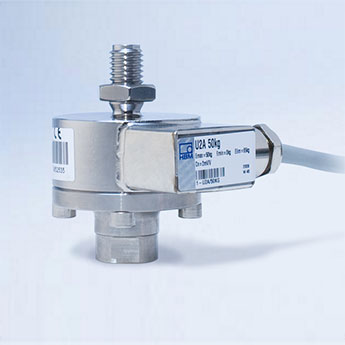The Working Principle of a Compression Load Cell
A load cell is a transducer that measures force, and outputs this force as an electrical signal. Most load cells use a strain gauge to detect measurements, but hydraulic and pneumatic load cells are also available.
Strain Gauge Load Cells
Strain gauge load cells usually feature four strain gauges in a Wheatstone bridge configuration, which is an electrical circuit that balances two legs of a bridge circuit.
The force being measured deforms the strain gauge in this type of load cell, and the deformation is measured as change in electrical signal. There are several common strain gauge load cell configurations, including shear beam, s-type, and compression.
How Does a Compression Load Cell Work?
Essentially, a compression load cell is a block that is designed to hold a load at one point to measure the compression. While tension load cells measure the pulling force, compression load cells measure a pushing force along a single axis. Generally, a compression load cell is placed beneath the object that needs measuring.
As mentioned previously, the strain gauge in a compression load cell is deformed when a load is applied, and this deformation is used to produce the measurement.
Depending on the application, compression load cells are used to determine any relative changes in resistance. Using the Wheatstone bridge circuit allows these relative changes to be measured with great accuracy, ensuring reliable results.
Compression load cells are generally made of materials that are resistant to rusting and scratches, as the base plate should be free from any deformity in order to provide precise results. A hardened cover is often used on the base plate to ensure this.
Compression load cells are specifically designed for application where space is limited, and they can be built to be extremely compact. They are also ideal for use for extremely high capacity loads – the compression load cells from HBM are available with maximum capacities of up to 50 tons.
These load cells are highly accurate, which is useful in industries where products are sold by weight. Many compression load cells are single point, which are extremely versatile and are able to measure off-centre loads, which is helpful for ensuring accuracy. Compression load cells also offer long-term stability, and this stability and accuracy can be further ensured with regular load cell calibration services offered by companies such as HBM.
The ease of measurement with a compression load cell helps to speed up processing and output, reducing the time spent obtaining results and ultimately lowering costs.
Compression Load Cells from HBM
HBM supply a selection of compression load cells, that are especially suited for use in process weighing, plant engineering, and tank weighing. We can supply these load cells with maximum measurement capacities from 50 kg to 5 tons, and accuracies of up to 0.1%.
We have approvals available for compression load cell installation in scales that are used in potentially explosive environments, or are subject to weights and measures legislation. International certificates for use are also available.
If you would like any more information about compression load cells, please contact us and a member of our team would be happy to provide support.
